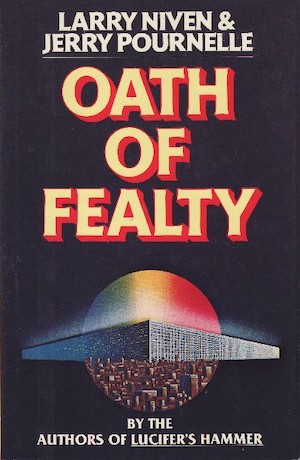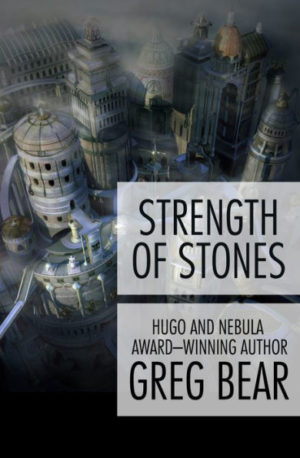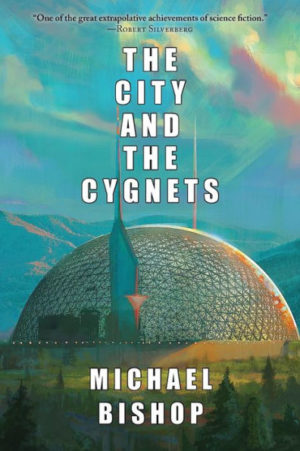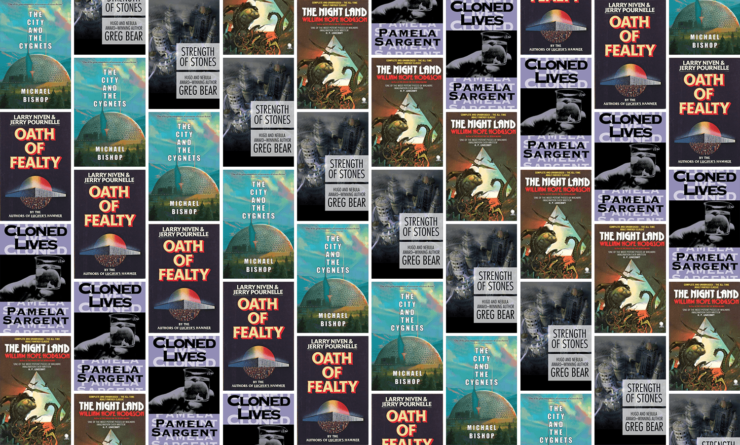The term arcology was coined by visionary architect Paolo Soleri in 1969, combining the words “architecture” and “ecology.” Arcologies were to be high-density, ecologically low-impact structures, with each one housing populations of thousands or more. Some architects envisioned arcologies that could be self-sustaining (or very nearly self-sustaining).
For many people, arcologies are a vision of a nigh-utopian mode of urban life. Pity, therefore, that nobody has ever managed to build one.1 Soleri’s Arcosanti, for example, broke ground half a century ago but never made Soleri’s vision reality, unless his vision centered around under-use and the occasional car-park fire. The issue may be that the technical challenges were greater than imagined half a century ago2 —or simply that at this moment, other approaches are far cheaper.
Science fiction authors are not limited by such mere practicalities. Thus, it’s not terribly surprising that arcologies and their kin appear from time to time in science fiction. Consider these five examples.
The Night Land by William Hope Hodgson (1912)

While Soleri coined the term arcology, the concept of a self-contained city was not original to Soleri. The Night Land is a notable early precursor to modern arcologies. The Last Redoubt houses within itself millions of people, providing everything required to sustain human life. Without the Last Redoubt, humanity would perish, for, just as Lord Kelvin foresaw, the energies generated by the Sun’s gravitational compression have run out and the sky is dark. To leave the Last Redoubt is to court unpleasant death.
The Lesser Redoubt was less fortunate than the Last Redoubt. Its Earth-Current3 (on which the vast city depended) failed, dooming all within. Despite which, some of its inhabitants appear to have survived… although perhaps not for much longer. Any attempt to reach the Lesser Redoubt is doomed by inclement conditions and the horrors that call the dark Earth home. Nevertheless, our hero is compelled to try, for he knows the latest reincarnation of the woman he loves is there. Rescue or death!
***
Cloned Lives by Pamela Sargent (1976)

Although the Americans of the early twenty-first century might not realize it, the United States in which they live is an expression of the technological exuberance of the futurist visionaries of a third of a century before. Automated highways provide safe, computer-controlled transit, power is generated by fusion and space-based solar power stations, and—of course!—arcologies provide a sensible solution for housing millions of Americans. It would be utopia were it not inhabited by humans.
Amongst the array of new tools available to humans: cloning animals. For ethical reasons, cloning is for the most part not used on humans. Instead, extinct animals are provided with a second chance to be driven into extinction by humans. “For the most part” has an exception: Visionary researchers used the window of opportunity before the moratorium on human cloning to produce five clones: Edward, James, Michael, Kira, and Albert Swenson. It is through their eyes that we tour the exciting world of an America that never came to be.
***
Oath of Fealty by Larry Niven and Jerry Pournelle (1981)

Sometimes, self-sufficiency is sold on its environmental merits. Todos Santos is not exactly self-sufficient, thus the mutually hostile relationship between the thousand-foot-tall city-building and the Los Angeles that surrounds it. If Todos Santos exemplifies any one concept, it is the gated community. In exchange for living in a panopticon state, those lucky enough to live within the vast building enjoy middle-class comfort untroubled by the unwashed masses who call the City of Angels home.
That’s the theory, anyway, but there is no plot in that. Among other things, Todos Santos is a giant target visible across Los Angeles, an affront to the undeserving poor and self-serving, blinkered politicians alike. Thus, the terrorism problem.4 It is a bold vision of the city-state of tomorrow5, portrayed with all the sensitivity and insight readers of Niven and Pournelle’s Lucifer’s Hammer have come to expect.
***
Strength of Stones by Greg Bear (1981)

Rather than settle their new world willy-nilly, the hopefuls who migrated to the planet they dubbed God-Does-Battle decided to start with a clear vision made into manifest reality. They hired Robert Kahn, humanity’s greatest architect, to design perfect cities, which they then built. Utopia could only result!
To quote Sartre, “Hell is other people.” Utopias tend to fell apart as soon as humans are introduced. Kahn’s cities had a simple solution: They expelled all the humans, to survive or not, as fate decreed on, the surface of God-Does-Battle. The arcologies were now free to operate without human complications.
A thousand years later, Kahn’s creations are beginning to run down, which may give the starvelings outside a chance to reclaim their lost homes.
***
The City and the Cygnets by Michael Bishop (2019)

If one wants people who can really get under Americans’ skins, one can do no better than Americans’ traditional enemies: other Americans. Small wonder, therefore, that once it became technologically possible for cities like Atlanta to surround themselves with a dome offering a controlled environment and seclusion from their vexing co-nationals, they did just that. Across the United States, but especially in Atlanta, the Domes facilitated a great turning inward.
As this mosaic novel reveals, living in a closed social bubble affords great opportunity to determine just what it is one does not like about one’s neighbors. Despite the best efforts of a theocracy that proves less pleasing in reality than it probably seemed in imagination, some free spirits do their best to prevail despite repression.
Of course, Atlanta is not completely sealed off from the outside world. External events can and do affect it. The beginning of the end of the closed Urban Nucleus comes in the form of unlikely immigrants: beings from another world…
***
No doubt you have your own favourite SF arcologies, or perhaps you just want to suggest Oath of Fealty even though it is mentioned above. Comments are below. Have at it.
(Hat-tip to mbmikhael for the idea)
In the words of Wikipedia editor TexasAndroid, prolific book reviewer and perennial Darwin Award nominee James Davis Nicoll is of “questionable notability.” His work has appeared in Publishers Weekly and Romantic Times as well as on his own websites, James Nicoll Reviewsand the Aurora finalist Young People Read Old SFF (where he is assisted by editor Karen Lofstrom and web person Adrienne L. Travis). He is a four-time finalist for the Best Fan Writer Hugo Award and is surprisingly flammable.
[1]Assuming one does not count the Walled City of Kowloon, which housed fifty thousand people on a footprint of less than three hectares. No matter how one classifies it, it was very impressive. At those densities, the entire population of the United States of America could be housed on an area less than 200 square kilometers.
[2]Soleri’s arcologies and Gerard O’Neill’s space colonies have a lot in common, ranging from utopian visions of closed-cycle self-sufficiency to the fact that none have ever been built.
[3]Let’s say this is geothermal energy. Why not?
[4]The reason there is a Canadian in this book (apparently based on some John Cleese character) is because the authors convinced themselves Canadians would regress into bootlicking colonials eager for foreign honours. As it turned out, that was just Conrad Black.
[5]Now a city of yesterday. Enough time has passed since the book’s publication that the future of the publication date is now in our past.











LOL.
Have I mentioned that I was well into Anathem before I realized that the places where people studied math and science all day long with limited (very limited) access to the news and media of the every day world were (in-universe) not a haven for people who must have been very very good in a previous life, but were considered by outsiders (if considered at all) a place to keep those dangerous, unsettling sciencey folks at arms’ length, available if needed for an emergency but otherwise well out of the way.
P.S. Technically, the concents in Anathem would count as arcologies – they keep working even if the outside world is a post-nuclear wasteland
I am pretty sure both of William Rotsler’s Patron of the Arts and To the Land of the Electric Angel featured arcologies but it’s been so long since I read either, I am not sure how.
The community in Piper’s Four Day Planet is functionally an arcology, a way of life forced on the settlers because the planet they’re on isn’t all that habitable.
Footnote 4 is glorious.
Conrad Black? That’s a name I haven’t heard in a long time.
Sim City 2000 had arcologies, which were expensive but great for population density. I don’t think they’ve shown up again though. An arcology simulator would make for a great computer game though
@2: Phil and Kaja Foglio’s “Girl Genius” throughout, I suppose, and especially a group of teenaged children of, generally speaking, mad scientists who live on Baron Wulfenbach’s airship to keep their parents out of trouble.
Also, Terry Pratchett’s pastiche of Leonardo da Vinci, Leonard of Quirm, noted for “designing powerful weapons while believing that nobody would be so bad as to use them” but fortunately kept in a secret comfortable dungeon by the Patrician of Ankh-Morpork so that consequences mostly don’t ensue.
My favorite is an arcology that covers the whole surface of the Earth: David R. Bunch’s Moderan. The great irony of Moderan is that it’s a dystopia whose inhabitants are thoroughly convinced it’s a utopia. The Earth is covered with a plastic coating, the oceans are pumped out into space, the lucky people become cyborgs with 90+% of their bodies “new-metal steel” (no mention is made of what happens to the unlucky ones), and they spend their seemingly eternal lives in constant warfare with each other.
It’s a glorious, bitterly funny book.
One word: Diaspar!
The domed city that carried the remnants of Mankind down the stream of time in Against the Fall of Night and The City and the Stars
@7 If that’s an arcology, then so is Trantor.
Ok, two not mentioned. The City and the Stars from Clarke, and Logan’s Run!
But James, why did you only mention Oath of Fealty once? That’s almost like leaving it out.
Can we mention Robert Silverberg’s The World Inside? Thousand-story skyscrapers and agoraphobia distinctly more acute than Asimov’s Cities.
The urban monads in Robert Silverberg’s The World Inside probably count as arcologies. Or maybe the next step up from an arcology, a sort of arcology of arcologies.
I feel like Robert Silverberg’s The World Inside counts even though its “urban monads” don’t really resemble Soleri’s idea, they are just very very very tall skyscrapers. When I first read it, I wasn’t sure why Silverberg had cities expanding only vertically despite what I’d assume were significant construction and maintenance hassles. But now I think there were clearly two reasons: 1. You need a lot of floors besides your floor because the other floors are where you do all the anonymous sex. 2. You need a very very very long trash chute to throw people down.
In my youth, I read a lot of Niven, and Niven and Pournelle. It is perhaps telling that while I remember reading Oath of Fealty, I remember almost nothing about it.
In Jose Saramago’s The Cave, a shopping mall called The Center is slowly expanding and taking over a city block by block, until the two viewpoint characters who were independent business owners find themselves without any customers other than the Center itself, and are later forced to relocate from their home into the Center, whic has its own living units, as dependents of their security guard son. The Center is designed so that you’d never need to leave and even has its own indoor sports venues, simulated ouydoor environemnt (no need to go outside for that) and amusement park / resort (the attractions are described as miniature versions of elements from other Saramago novels). It’s also a panopticon, of course. So, Walmart as an arcology, basically (Saramago was not a big fan of capitalism).
Lois McMaster Bujold’s Komarr has arcologies. It is impossible to survive on the planet outside them, as the Komarr atmosphere doesn’t have enough oxygen to support life.
I’d commend the Chung Kuo series by David Wingrove for this list. Utterly massive arcologies – more megastructures, really.
Per the Little Black Rule, high population, high technology worlds in Traveller tend to have arcologies. On sufficiently high tech worlds, gravity generators are used both to make the elevators fast enough to be practical, and to allow the buildings to stand in the first place. Don’t forget to pay the electric bill. (Though more likely they’re powered in situ by Fusion+ units.)
Ah, Chung Kuo, you started off so promisingly, then threw away your premise for gigadeathcrimes and a villain who turned out to be a giant spider from another universe, which the writer had planned from the beginning as surely as I am tsar of all the Russias.
Similar to Chung Kuo and Trantor, but NOT ARCOLOGIES because covering the entire land surface of a planet with buildings deserves a different name, in Galactic Bloodshed you could eventually pave and build up every single tile on a planet. (GB is memorable mainly for two things: the usual client was terribly coded (main() contained an infinite loop with no exit… which called another function that contained an infinite loop with no exit, among other sins), and every time I signed up for a game, my university would lose its network connection for the first few vital days.)
What, no love for Biosphere 2?
I seem to recall that the “lost jungle city” of Xuchotil in the Robert E. Howard Conan story “Red Nails” was effectively one giant, self-contained building. Not really a utopian place, though. (Even before Conan and Valeria’s visit ends up finishing off the small remnant population.)
My main recollection of Oath of Fealty is the iceberg that they floated to LA to get drinking water from. I don’t remember if they shared the water with the rest of Southern California or kept it for themselves.
@19: Biosphere 2 would be more impressive if it actually worked.
So, I’m just going to drop Stephen King’s Under the Dome here. It’s kind of like the anti-arcology: lots of people are trapped and trying to get out of a dying town that was never intended to survive on its own. I know it doesn’t quite fit, but when I read the description at the top, all I could think about was the cover art for the edition I read… And then the TV show (which I didn’t like) and the Simpsons Movie parody (which I did like)
22: Sufficiently comprehensive failure is also impressive. Would anyone remember the Titanic if it had made it all the way across the Atlantic?
The Biosphere II people learned a lot, at least according to the memoir by one of the first biosphereans:The Human Experiment by Jane Poynter. A properly documented experiment can be a success even if it doesn’t achieve the ultimate goal hoped for the entire experimental project.
The City from H. M. Hoover’s classic juvenile novel This Time of Darkness. Mostly underground but the upper class live in a vast series of domes.
On the footnote on The Night Land – I’d not even worried about the scientific explanation for what the Earth Current was. I’d already read a load of Hodgson, so I just assumed it was similar to things mentioned in other stories, such as the Carnacki ones. Given the story already relies explicitly on metempsychosis, I don’t think it’s so important to think of a vigorous scientific explanation – though I admit, that would be fun (for that and many of the other things encountered in the novel)!
For some reason I’m thinking of Gormenghast, comparable its attitudes to the people outside to the arcology in Oath of Fealty, but very unlikely to have been its model.
While Gormenghast was a large, rambling castle, the people who lived within never left and have very little interaction with the people living outside of it.
Paolo Bacigalupi’s Water Knife features arcologies.
18: covering the entire land surface of a planet with buildings deserves a different name
Ecumenopolis is the term for world-city. It comes up a lot in Isaac Arthur’s Science and Futurism videos on YouTube.
No Caves of Steel?
One more story that comes to mind that includes domed cities, is After Worlds Collide, with the pristine domed cities the Bronson Betas built as their world left their star system. All connected by a subway system and somehow, the lord knows how, still mostly functional after being in the deep freeze for how many billions of years…
The Arcosanti was about the only saving grace of the 1988 film version of Asimov’s Nightfall.
I wonder if the cities in Walter Jon Williams’ Metropolitan would qualify?
Paradise Towers, from classic Doctor Who. I don’t remember if they were actually called arcologies, but I think they qualify. They were designed by an architect who hated having grubby humans muck up his perfect buildings and so killed them off at every opportunity.
Elisabeth Hand’s Æstival Tide, which is the middle volume of her early Winterlong trilogy.
Do underwater arcologies count? Michael Reeves and Stephen Perry wrote the aptly named novel, “Dome,” one of the earliest sci-fi books I remember reading. Lots of political shenanigans in the arc.
#28, Gormenghast came to my mind also. I think it might count as an “accidental arcology”, accumulating in a semi-organic manner rather than as a pre-planned unit. (The Walled City of Kowloon, cited in footnotes, might be a real-life example.) The floating city of Armada, in China Mieville’s The Scar, might be another example.
Cities In Flight. New York City (The Five Burroughs) has left the Earth through the implementation of the Spindizzy Interstellar Drive. The city is self sufficient and travels time and space only to create a new universe. There are other cities in the story but NYC and its mayor are the main characters. Self sufficiency and the collective authority of the “City Fathers” make NYC an arcology.
So, if we are going to allow space habitats and off-world settlements then I can think of nothing more apt than Tycho Under from Heinlein’s. “The Moon is a Harsh Mistress”. Then, of course, there are all of the Areologies of the Martian sagas by Robinson and Bear. Speaking of Bear, in his masterpiece “Eon” the singularity he calls the “Way” is connected to the “Potato” which is the hollowed out asteroid that began the adventure. As an aside, am I the only one who dreamed that they would see a day when I was asked to prove that I was not a robot? Asimov would have been equally proud and appalled.
Do the utopias and dystopias described in Gulliver’s Travels count?
@39 John,
Mayor Amalfi explicitly stated early in book 2 that New York City was specifically just Manhattan.
There’s a story, possibly by Ballard, about experimental arcologies to see how people handle extremely dense living conditions. It was in one of Terry Carr’s anthologies. People didn’t believe in an outside to the arcology, and they made intricate little clockworks.
I think “The Luckiest Man in Denv” by Kornbluth was an arcology.
Real World attempts at expert designed cities and buildings haven’t worked out too well. Le Corbusier For example had a very austere and limited ideal for how people should live that most of us would very much dislike.
In Corbo’s defence, his Plan Voisin (to turn Paris into an endless plane of identical high rises) was an abomination for which he should have been walled up next to Fortunato.
Fortunato? I get the feeling Corbusier just didn’t like people much judging from the blank boxes he wanted to store them in.
It’s astonishing how bad architects are at figuring out good ways for people to live. And the bigger the name, the worse they seem to be at it.
What about the Mega-City One city blocks in Judge Dredd, and High-Rise by J. G. Ballard? They’re not exactly intended to be arcologies, but they pretty much end up that way.
Oath of Fealty was terrible. Biased, heavy handed, preachy, and clunky. Niven and Pournelle’s fiction usually had enough science and enough adventure that you didn’t pay too much attention to the politics. Not this one, though.
princessroxana@47, I find myself wondering what Corbusier’s own house was like, and, well, it’s just been restored and it’s not too bad-looking inside, actually, if rather a disjointed mess of differing styles. The outside looks to be fairly yuck.
What about entire spheres? Such as Ringworld by Larry Niven.
@21: don’t forget the fission plant they ran in Mexico to avoid US laws; ISTR that it produced hydrogen (which would have been a bear to pipe) rather than electricity. I’ve been wondering recently what Pournelle would make of his slogan “Think of it as evolution in action” wrt the anti-vaxxers.
Have any arcology stories addressed the people who do the scut work? N&P at least seemed to have only middle-class inhabitants, but somebody had to pack up their trash; what arcologies providing living space for people who couldn’t afford monster rents?
53. As far as avoiding laws, I remember back in the days of Usenet, someone on one of the rec.arts.sf.* groups did a pointed satire of Oath of Fealty, where the damn thing caught fire. One of the major things it turned out the libertarian builders were good at was ignoring safety and emergency procedures, such as not using flammable materials, or putting in real fire suppression equipment. And of course the evacuation procedures were “Every man for himself.”
IIRC it really annoyed the libertarians in that group.
@21,
They just took the tax breaks and subsidies. They wouldn’t give anything in return.
@54,
Did the writer forget the furnishings made from plastic that released toxins when burned?
princessroxana @@@@@ 47, it’s a reference to “The Cask of Amontillado” by Poe:
“The Machine Stops” by E.M. Forster describes a future civilization of arcologies that covers the Earth, except that the arcologies are all underground. Which, as it turns out, is a problem.
@57, Ah, thank you! I assumed it was an architectural reference. Not that I’ve read much Poe. I like to sleep at night
Do Warhammer 40k Hive Cities count as arcologies? Nothing utopian about them!
@58: If they think they live in the best of all possible worlds, it does. The inhabitants of the Machine in the story I referenced @57 live dreary, constricted lives, but assume that they are the full flowering of civilization. Similarly, the trillions of inhabitants of the massive arcologies in The Godwhale by T.J. Bass are convinced that they have it good, although to an outside observer they resemble highly specialized lab mice in a facility that grudgingly does the bare minimum of enrichment.
As I recall, the people who programmed the AIs that run the Hive in Godwhale were insufficiently precise about what good means in the phrase “the greatest good for the greatest number.”
@54: I’m sorry I missed that. (That was probably after I’d gone cold turkey on Usenet as it was eating my life — back in the days when more people had lives beyond their computers.) I can think of at least one person who’d publicly spanked Pournelle for an online temper tantrum some years before and would have relished the task. I hadn’t thought of that issue — but given corporate procedures in the US even then, I’d be surprised if that arcology hadn’t been built by a string of corner-cutting cheapest contractors, followed by lipstick-on-a-pig decorators to make people think moving in was safe. The best thing about the destruction would be that possible inhabitants of planned arcologies would be harder to con.
@60–Yep. If you get a promotion you are allowed to choose flavors for your nutrient paste! Six of them!
@53: Scope out the plight of the INFRARED-level clones in West End Games’ Paranoia ™(r)(lsmft) RPG. The “DOA Sector Travelogue” lays out Alpha Complex in delightfully lethal detail. (“It’s good to be da ULTRAVIOLET High Programmah!”)
Serve The Computer! The Computer is your Friend!
What is your security clearance, loyal citizen???